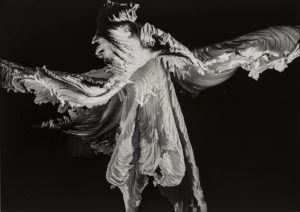
Carlotta Corpron (American, 1901-1988), Nature Dancer, 1944, Gelatin silver print, Museum purchase, 74.123
During a week when NOMA’s team looks toward our permanent collection for examples of plant life and floral beauty, it may seem strange to focus on the humble cabbage. Carlotta Corpron’s Nature Dancer, however, elevates leaves of Chinese cabbage out of the kitchen and into our imaginations. The sense of motion is incredible, and at first glance it seems like she might have photographed a flamenco dancer, twirling a voluminous dress and drape. Consider Corpron’s Dancer alongside Edward Weston’s Cabbage Leaf (1931). A magnificent photograph in its own right, Weston’s work does imbue the plant with a corporeality, but also a declining vitality. Perhaps the most-well known photographer of produce, Weston does not shy away from the already wilting edges of the leaf, and our eye is drawn to the bruise and tear at its center. For all of its force, the overall impression of Weston’s cabbage is one of decline, while Corpron photographed her cabbage in a way that shouts energy, life, and beauty. The dark background helps to enhance the sense that the dancer is under a spotlight, and reveals every wrinkle and jagged edge on the leaf.
An important photographer and teacher in Texas, Corpron became known throughout the world for her experimentation with “light poetry” and her careful and creative use of lighting is on display here. Influenced by Man Ray and with Laszlo Moholy-Nagy, Corpron excelled at abstract photography, often employing natural or organic elements in her compositions.
—Brian Piper, Mellon Foundation Assistant Curator of Photographs
Many photographs from NOMA’s permanent collection are featured in Looking Again: Photography at the New Orleans Museum of Art (NOMA and Aperture, 2018). PURCHASE NOW
NOMA is committed to uniting, inspiring, and engaging diverse communities and cultures through the arts — now more than ever. You can support NOMA’s staff during these uncertain times as they work hard to produce virtual content to keep our community connected, care for our permanent collection during the museum’s closure, and prepare to reopen our doors.
▶ DONATE NOW

